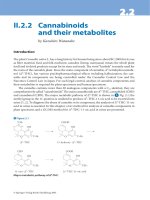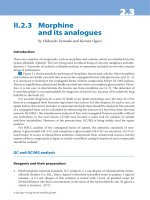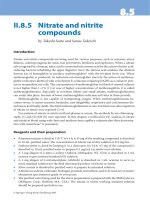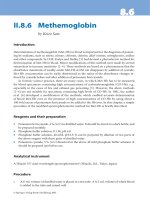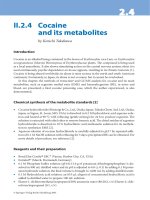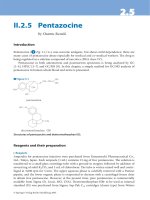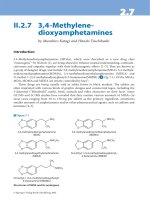Drugs and Poisons in Humans - A Handbook of Practical Analysis (Part 20)
Bạn đang xem bản rút gọn của tài liệu. Xem và tải ngay bản đầy đủ của tài liệu tại đây (239.21 KB, 8 trang )
2.22.2
© Springer-Verlag Berlin Heidelberg 2005
II.2.2 Cannabinoids
and their metabolites
by Kazuhito Watanabe
Introduction
e plant Cannabis sativa L. has a long history for human being since about BC 2000 for its use
as ber material, food and folk medicine; cannabis ( hemp, marijuana) means the whole plant
itself and its dried products except for its stem and seeds. e word “ hashish” is mainly used for
the resin of the cannabis plant. Since the main component of cannabis, ∆
9
-tetrahydrocannabi-
nol ( ∆
9
-THC), has various psychopharmacological e ects including hallucination, the can-
nabis and its components are being controlled under the Cannabis Control Law and the
Narcotics Control Law in Japan. For such legal control, analysis of cannabis components and
their metabolites is required for plant specimens and human specimens.
e cannabis contains more than 60 analogous components with a C
21
skeleton; they are
comprehensively called “cannabinoids”. e main cannabinoids are ∆
9
-THC, cannabidiol ( CBD)
and cannabinol ( CBN). e major metabolic pathway of ∆
9
-THC is shown in > Fig. 2.1; the
methyl group in the 11-position is oxidized to produce ∆
9
-THC-11-oic acid to be excreted into
urine [1, 2]. To diagnose the abuse of cannabis or its component, the analysis of ∆
9
-THC-11-oic
acid in urine is essential. In this chapter, a GC method for analysis of cannabis components in
plant specimens and a GC/MS method for ∆
9
-THC-11-oic acid in urine are presented.
Major metabolic pathway of ∆
9
-THC.
⊡ Figure 2.1
188 Cannabinoids and their metabolites
GC analysis of cannabinoids in plant specimens
a
Reagents and their preparation
• Extraction and puri cation of cannabinoids [3]:
Cannabis sativa L. is being grown at Hokuriku University, Faculty of Pharmaceutical
Sciences with permission from the Government. e dried plant is minced and immersed
in 20 volumes of methanol for 2 days for extraction; this procedure is repeated once. e
combined methanolic extracts are evaporated to dryness. e residue is decarboxylated by
heating at 140 °C for 20 min. e treated residue is applied to a 20 volumes (against the
weight of the plant) of orisil and eluted with benzene for partial puri cation to remove
chlorophyl. Finally, column chromatography with 50 volumes of silica gel is performed
using benzene/n-hexane/diethylamine (25:10:1, v/v) as eluting solvent for getting each
cannabinoid standard.
• ∆
9
-THC, CBD and CBN are separately dissolved in ethanol to prepare 0.05–0.5 mg/mL
standard solution for each compound
b
.
• 5α-Cholestane (Sigma, St. Louis, MO, USA) is dissolved in ethanol to prepare a 0.5 mg/mL
solution for use as internal standard (IS).
GC conditions
GC column [4]: a fused silica capillary column (slightly polar), HP-5MS (30 m × 0.25 mm i. d.,
lm thickness 0.25 µm, Agilent Technologies, Palo Alto, CA, USA); MDN-5S (30 m× 0.25 mm
i. d., lm thickness 0.25 µm, Supelco, Bellefonte, PA, USA).
GC conditions; an Autosystem XL (Perkin Elmer, Wellesley, MA, USA) and an FID were
used. Column (oven) temperature: 50°C (2 min) →20 °C/min→200 °C(0.5 min)→5 °C/min→
300 °C(5 min); injection temperature: 250 °C
c
; carrier gas ( ow rate): He (1 mL/min); FID gas
( ow rate): air (400 mL/min) and H
2
(40 mL/min); make-up gas ( ow rate): N
2
(30 mL/min);
injection volume: 1 µL (split ratio 1/50).
Procedure
i. A dried specimen is minced and extracted with 10 volumes of methanol with stirring for
10 min at room temperature.
ii. e above methanol extract is condensed or diluted to an appropriate amount and mixed
with a xed amount of 5α-cholestane (IS).
iii. A 1-µL aliquot of the above extract is injected into GC for qualitative analysis and for quan-
titation using the below calibration curve.
iv. Construction of a calibration curve: the standard solutions at 0.05–0.5 mg/mL mixed with
a xed amount of IS each are prepared for each cannabinoid, and a 1-µL aliquot of each
solution is injected into GC to construct a calibration curve with cannabinoid concentra-
tion on the horizontal axis and with peak area ratio of a cannabinoid to IS on the vertical
axis.
189
Assessment and some comments on the method
> Figure 2.2 shows a gas chromatogram for ∆
9
-THC, CBD, CBN and cannabichromene
( CBC) obtained under the GC conditions. e peaks of ∆
9
-THC (22.2 min), CBD (20.6 min)
and CBN (23.2 min) are separated well; but the peak of CBC may overlap that of CBD.
When the dried cannabis is analyzed, the peaks of cannabinoids are not interfered with by
impurity peaks in background, because the total concentration of cannabinoids in the dry
specimen is as high as 0.5 %. For the specimen which had been stored for a long time, ∆
9
-THC
and CBD are converted into CBN by oxidation reaction, resulting in relatively high concentra-
tions of CBN [5]. For discrimination of seeds, a GC method for cannabinoids with benzene
extraction was reported [6].
e con rmatory test for cannabinoids should be made by GC/MS. For this purpose, the
mass spectra of ∆
9
-THC, CBD, CBN and 5α-cholestane (IS) are shown in > Fig. 2.3.
⊡ Figure 2.2
Gas chromatogram for cannabinoids. 1: CBD; 2: CBC; 3: ∆
9
-THC; 4: CBN; 5: 5α-cholestane (IS).
⊡ Figure 2.3
EI mass spectra of ∆
9
-THC, CBD, CBN and 5α-cholestane.
GC analysis of cannabinoids in plant specimens
190 Cannabinoids and their metabolites
GC/MS analysis of ∆
9
-THC-11-oic acid in urine
d
Reagents and their preparation
• ∆
9
-THC-11-oic acid can be synthesized by the method of Pitt et al. [7]. e author et al. are
using the compound supplied by the National Institute on Drug Abuse in USA. e authen-
tic compound is dissolved in ethanol to prepare 0.1 mg/mL solution. IR, γ
CHCl
3
1,680 cm
–1
;
NMR (CD
3
COCD
3
) δ: 1.08, 1.39 (s, 3H × 2, gem-CH
3
), 3.38 (d, C
10a
-H), 6.15, 6.30 (s,
1H × 2, aromatic-H), 8.10 (m, 1H, C
10
-H); MS, m/z 344 (M
+
).
• 5′-Nor-Δ
8
–THC-4′-oic acid was synthesized by the method of Ohlsson et al. [8]. e com-
pound is dissolved in ethanol to prepare 0.1 mg/mL solution. IR, γ
CHCl
3
1,710 cm
–1
; NMR
(CDCl
3
) δ: 1.10, 1.38 (s, 3H × 2, gem-CH
3
), 1.70 (s, 3H, C
9
-CH
3
),
3.22 (dd, 1H C
10a
-H),
5.42 (m, 1H, C
8
-H), 6.07, 6.24 (s, 1H × 2, aromatic-H); MS, m/z 330 (M
+
).
• e solution of 5α-cholestane (IS) is also prepared with the same procedure as those of the
above two compounds.
GC/MS conditions
Analysis with a packed column [9]; column: 5 % SE–30 (2 m × 2 mm i. d.); GC/MS: a JEOL
GCG-06 gas chromatograph connected with a JEOL JMS-DX300 mass spectrometer (JEOL,
Tokyo, Japan); column (oven) temperature: 250 °C; injection temperature: 270 °C; carrier gas:
He; its ow rate: 40 mL/min; electron energy: 70 eV.
Analysis with a capillary column [10]; column: DB-5 or DB-1 (30 m × 0.25 mm i. d., J & W
Scienti c, Folsom, CA, USA); GC/MS: a Varian Model 3500 gas chromatograph (Varian,
Harbor City, CA, USA) connected with a Finnigan MAT ITS 40 GC/MS system ( ermo-
Finnigan, San Jose, CA, USA); column temperature: 180 °C→20 °C/min→280 °C; injection
temperature: 300 °C; carrier gas: He; its ow rate: 1 mL/min; electron energy: 70 eV.
Procedures
i. Liquid-liquid extraction
i. A 10-mL volume of urine and 10 mL of 10 M NaOH solution are placed in a glass centrifuge
tube with a ground-in stopper
e
and heated at 50 °C for 15 min in a water bath for hydrolysis
f
.
ii. A er cooling to room temperature, 2 mL of 1 M potassium dihydrogen- phosphate solu-
tion is added to the mixture and its pH is adjusted to 2–3 by adding hydrochloric acid.
iii. A 20-mL volume of n-hexane/ethyl acetate (7:1) is added to the mixture, shaken for 10 min
and centrifuged [9].
iv. e organic phase is carefully transferred to another centrifuge tube of the same type,
mixed with 5 mL of 0.5 M NaOH solution, shaken for 10 min and centrifuged at 3,000 rpm
for 5 min.
v. e organic phase is discarded by aspiration; 2 mL of 1 M potassium dihydrogenphosphate
solution is added to the aqueous phase and its pH is adjusted to 2–3 with hydrochloric acid.
191
A 20-mL volume of n-hexane/ethyl acetate (7:1) is added to the above solution to extract
∆
9
-THC-11-oic acid again
g
.
vi. e organic phase is dehydrated with anhydrous sodium sulfate, passed through lter pa-
per and evaporated to dryness.
ii. Solid-phase extraction [10]
i. A 2-mL volume of the hydrolyzed urine obtained a er step i) of the above procedure is
mixed with a xed amount of IS
h
, and poured into a Bond Elut Certify II column (Varian,
Harbor City, CA, USA), which has been activated by passing 2 mL methanol and 2 mL
water, at a ow rate of about 1 mL/min [10].
ii. e column is washed with 9 mL of 50 mM phosphoric acid solution and 3 mL of 50 mM
phosphoric acid solution/methanol (4:1).
iii. A er drying the column under reduced pressure, the target compound and IS are eluted
with 2 mL of n-hexane/ethyl acetate (4:1) containing 1 % acetic acid and evaporated to dry-
ness under a stream of nitrogen.
iii. Derivatization-1
One of the above dry residues is dissolved in 10 µL acetonitrile, 15 µL of N,O-bis(trimethylsi-
lyl)tri uoroacetamide ( BSTFA) and 5 µL trimethylchlorosilane ( TMCS), and heated at 60 °C
for 20 min. A er cooling, a 1-µL aliquot of it is injected into GC/MS.
iv. Derivatization-2
One of the above dry residues is dissolved in 2 mL of solution of diazomethane in ethyl ether
i
,
le at room temperature for 30 min and evaporated to dryness. e residue is then subjected
to the above Derivatization-1 for trimethylsilylation to obtain methyl ester plus TMS deriva-
tives. A 1-µL of the solution is subjected to the GC/MS analysis.
v. Quantitation
By using various amounts of ∆
9
-THC-11-oic acid and an xed amount each of IS, which had
both been spiked into blank urine, a calibration curve is constructed for quantitation of the
acid in a test urine specimen.
Assessment and some comments on the method
Jones et al. [11] reported that ∆
9
-THC-11-oic acid was stable during storage at –18 °C for
2 months. e author et al. con rmed that the compound did not change at –20 °C for at least
2 months.
∆
9
-THC-11-oic acid is known to be decarboxylated at high temperatures; it, therefore, is
necessary to be derivatized for GC/MS analysis. Baker et al. [12] examined various derivatiza-
tions and reported that the methyl ester plus TMS derivative of the acid gave the highest sensi-
tivity, although the two-step derivatization procedure is required.
> Table 2.1 shows major ions of mass spectra for ∆
9
-THC-11-oic acid, 5α-cholestane and
5’-nor-∆
8
-THC-4’-oic acid obtained by both derivatization methods. For the ∆
9
-THC-11-oic acid,
the base peak appeared at m/z 371 and is most suitable for quantitation by SIM.
> Figure 2.4
shows mass spectra of ∆
9
-THC-11-oic acid a er the TMS and methyl ester-TMS derivatizations.
GC/MS analysis of ∆
9
-THC-11-oic acid in urine


